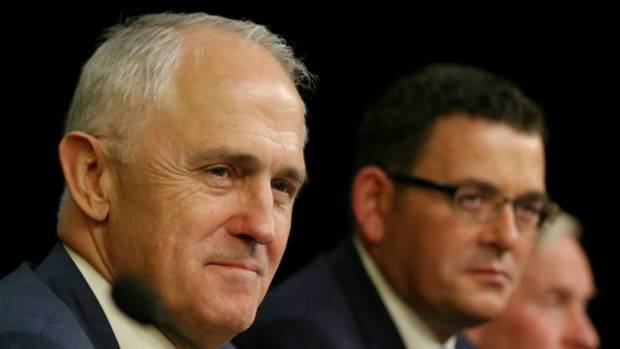
The Labor states have reacted angrily to suggestions by Malcolm Turnbull that they should abandon their own state-based renewable energy targets, accusing the prime minister of peddling “ignorant rubbish”about wind and solar in the wake of the South Australian blackout.
Turnbull and his Coalition partners, along with One Nation, Nick Xenophon, the mining and energy lobbies and conservative commentators, have been accused of launching a scare campaign over renewable energy, even though market and grid operators agree it had nothing to do with this week’s major outage.
Turnbull and energy minister Josh Frydenberg have both condemned the state-based targets as “extremely aggressive, extremely unrealistic” renewable energy targets, with the implication being that they would threaten the stability of the electricity system.
Victoria premier Daniel Andrews accused Turnbull of promoting “anti-climate change, anti-fact nonsense” and of “ignorant rubbish”, and said the comments drew a remarkable similarly to the rhetoric of his climate-denying and anti-renewable predecessor Tony Abbott. At least Abbott appeared to believe what he said, Andrews suggested.
“This is a natural disaster and the Prime Minister is peddling completely ill-informed rubbish about how we generate our energy,” the premier told ABC radio. “It seems Tony Abbott’s back.”
The Turnbull government is now suggesting a new national target, but it has only suggested a longer dated renewable energy target, not a higher one. After being cut back by the Abbott government from 41,000GWh to 33,000GWh, the national target would result in about 23.5 per cent renewables by 2020.
The states are aiming much higher. Victoria is aiming for 40 per cent by 2025, and has already outlined its likely policy initiatives, and Queensland is targeting 50 per cent by 2030. South Australia is also targeting 50 per cent by 2025, but it practically there already without having any specific state-based policy initiatives.
The ACT is aiming for 100 per cent renewables by 2020, and has already locked in contracts with wind and solar projects to achieve that target, while the new Labor government in the Northern Territory is aiming for 50 per cent by 2030.
All the states have ruled out chaining their target to accommodate a weaker national one, arguing that their targets are needed for economic and jobs growth and investment, and to play their part in environmental and climate change goals.
“I thought the Prime Minister wanted more renewables – at least that’s what he said at the election,” Queensland Premier Annastacia Palaszczuk told The Australian newspaper.
Victorian energy minister said there is no evidence that renewable energy played a part in what has occurred. “It doesn’t matter if energy is created by coal, nuclear, gas or renewable sources. Without power lines it cannot go from point A to point B,” she said in a statement.
“Rather than peddle mistruths, Malcolm Turnbull and Barnaby Joyce should start providing some national leadership and focus on developing a renewable vision beyond 2020.”
In an interview on Radio 3AW, Turnbull insisted he was “a very strong supporter of renewable energy.” Since arriving in power a year ago, however, the only policy initiative he has put forward is to slash the Australian Renewable Energy Agency funding.
At first, he wanted to remove it altogether, but after a public backlash agreed to cut it by $500 million. To accomodate that change, the Coalition then advised that it would remove nearly all the funding for the Clean Energy Innovation Fund.
Labor climate change spokesman Mark Butler noted that during the recent election campaign, Turnbull had said: “South Australia is a leader in clean energy generation, also benefits from our programs which support renewable including of course the RET.”
Now, Butler noted, Turnbull had started a “misinformed” and “ideological” attack on renewables. “This is further proof that Malcolm Turnbull is a fraud and will do anything to keep the right wing radicals happy, even politicise a super storm and ditch his old beliefs,” Butler said.
The Clean Energy Council seized upon Turnbull’s talk of a new national target, saying that it was an opportunity to provide solid, more ambitious and longer dated targets.
“If we are now talking about the harmonisation of state and federal schemes following the torturous review of the RET which ended last year, this can only mean longer and stronger targets that encourage new investment beyond 2020,” CEO Kane Thornton said.
“It is important to recognise that investment stability is crucial and any discussion about future policy harmonisation must respect the massive investment already in place and the need for continued policy stability to build confidence in the Australian industry.”










